Bye bye 2007, Hellooooo 2008! If you were anything like the rest of us, you probably made a New Year’s resolution of getting back in shape. Well, lucky for you, World Wide Ed’s got ‘cho back! We’re going to start off the year right by taking a break from all the eating and instead, going on a little hike up one of Oahu’s landmark treasures: Diamond Head.

Diamond Head State Monument Sign
Diamond Head, also known as Le`ahi, is believed to have been created about 300,000 years ago during a single brief eruption of the southeastern end of the Ko`olau Range. Since the winds were blowing the volcanic ash towards the west during the eruption, the southwestern rim is the highest point, forming its now famous shape.
Diamond Head got its name in the late 1700 when the Western explorers visited it and mistook the calcite crystals in the rocks on the slope of the crater for diamonds. Previous to that, it is said that Hi`iaka, sister of the fire goddess Pele, named it Le`ahi because the summit resembled the forehead (lae) of the `ahi fish.
The rich history behind this gorgeous range led it to be recognized as a National Natural Landmark in 1968. Today millions of tourists and locals alike, enjoy both the legendary view from afar, as well as the breathtaking view from atop the summit, culminating its 0.8 mile historic trail hike.
We start our journey by driving into the State Monument off of Diamond Head Road (optionally, you can find street parking nearby and walk in). Not long into the drive off Diamond Head Road, you’ll approach the Kahala Tunnel,
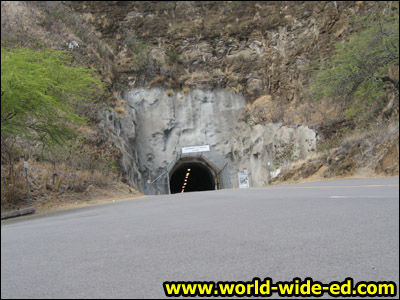
Kahala Tunnel on the way to Diamond Head State Monument
which you’ll drive through to get to a clearing…
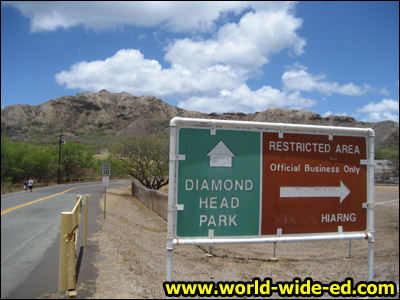
Sign to Diamond Head Park
that directs you to the parking lot area.
(Note! – The admission fee is $1 per person on foot or $5 per non-commercial vehicle. If you’re looking to save some paper, consider walking it from Diamond Head Road as suggested earlier. If you’re looking to save your energy for the hike itself, drive on in. You may have to wait in line for a stall, but the wait usually isn’t too long).
At the admission’s gate or Information Center, be sure to pick up the green brochure before you hike the trail. There is a handy map, some history of the park and tips on having a safe hike. It will be an even better idea if you download it ahead of time here from the Department of Land and Natural Resources’ Hawaii State Parks web site.
Speaking of the map, let’s show it to you here. We’ll try to follow the 12 Points of Interest (endearingly renamed by me to POI) listed in the brochure with the images I took. Should be fun times, let’s see what happens…
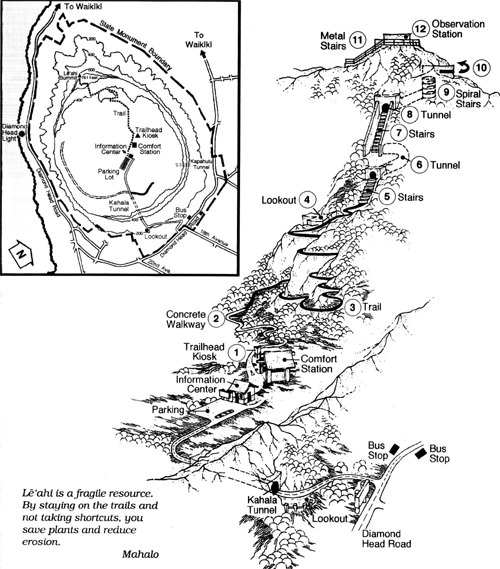
Diamond Head Trail Map courtesy of the Department of Land and Natural Resources Division of State Parks
Just past the comfort station, POI1 (Point of Interest #1) is the Trailhead Kiosk and described as follows: the trailhead at the parking lot is on the crater floor. Elevation of 200 feet (61 m).
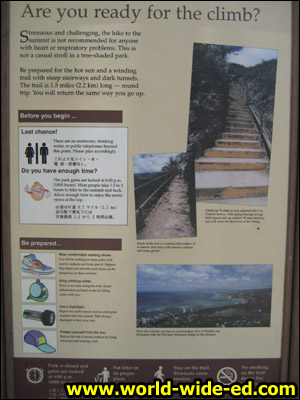
Trailhead Kiosk
The brisk 0.8 mile one way climb to the summit is said to take about an hour to an hour and a half. This is usually in the scorching heat, and not always on a paved path, so be sure to bring water, good footwear, and lather yourself up with sun tan lotion. Some other trail notes to adhere by:
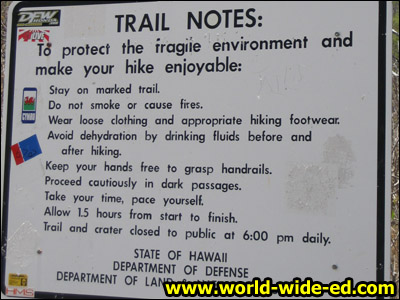
Trail Notes sign
This leads us to POI2: the Concrete Walkway – the concrete portion of the trail was recently installed to reduce trail erosion. The former pistol ranges are marked by earthen berms visible along the lower section of the trail.

Concrete Walkway
Once the concrete walkway turns to dirt,
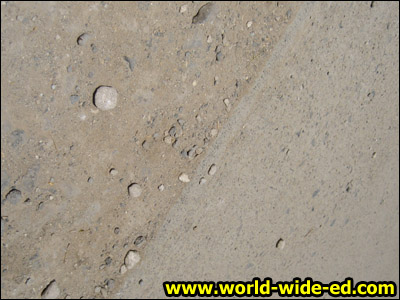
you’re well on your way. POI3 consists of a multiple switchback trail that zigzags its way up the interior slope. Historically, it was designed for mules that hauled materials up the trail for the construction of Fire Control Station Diamond Head located at the summit. Following are some neat shots I took from POI3: The dirt trail conforms to the 1908 trail alignment and consists of numerous switchbacks up the steep interior slope.
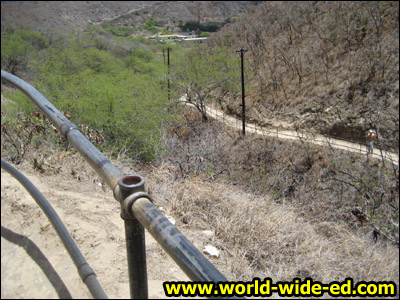
Scenes from the switchback trail
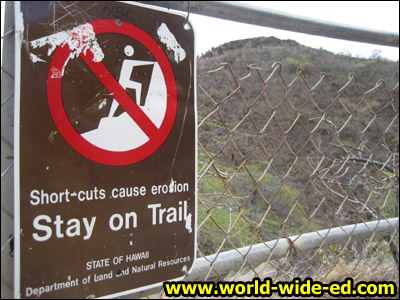
Scenes from the switchback trail – Stay on Trial sign
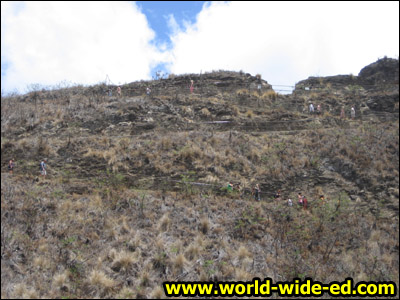
Scenes from the switchback trail – Looking up towards the lookout
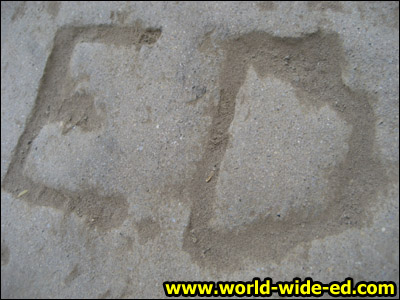
Scenes from the switchback trail – You know I had to do it!

Scenes from the switchback trail

Scenes from the switchback trail – Looking back from the lookout.
Upon completion of the zigzagging portion of the trail, you’ll hit POI4: the Concrete Landing/Lookout. This foundation held a winch and cable to lift materials from the crater floor to a point on the trail.

Enjoying the view from the lookout
Don’t get too relaxed! The toughest gluteus maximus workout is yet to come with two daunting stair sets, the first of which is 74 steps and POI5: Steep stairway of 74 concrete steps leading into the first tunnel.

74 Step Staircase – View from below
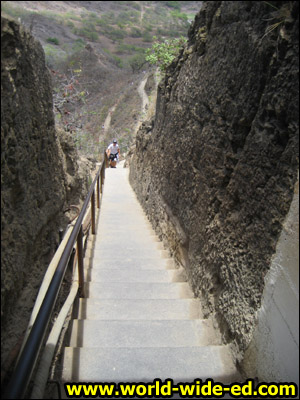
74 Step Staircase – View from above
Scary isn’t it? You ain’t seen nuthin’ yet. Once you burn your legs for those 74 steps and pass through the POI6 tunnel – Passage through a lighted 225-foot long, narrow tunnel,

225 foot long tunnel separating the two staircases.
you’re faced with 99 additional big ones at POI7: Second stairway consisting of 99 steep steps. The cross-beams above the stairway supported camouflaging.

99 Step Staircase
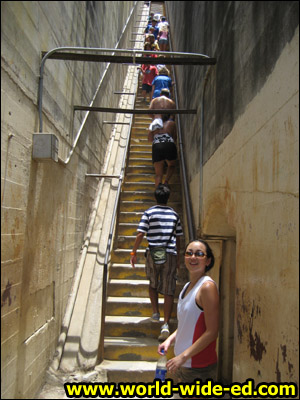
99 Step Staircase

99 Step Staircase – Elevation 703.556 feet
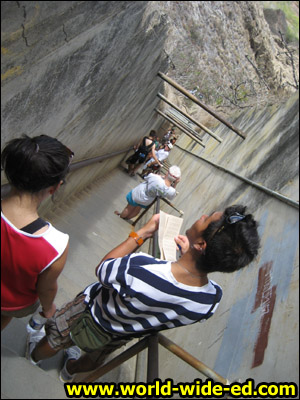
99 Step Staircase – Looking down
(Note!: After the tunnel separating the two staircases, turn left to take in another lookout point not mentioned in the brochure. This will also give you a good place to take a break before taking on the 99 step behemoth.)
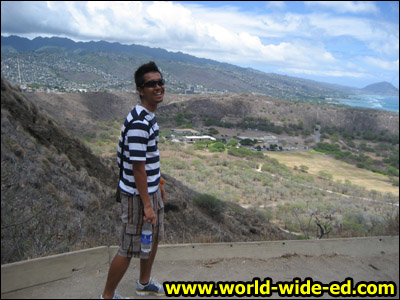
My second cousin Teppei enjoying the view as well as the break between steps.
You’ve done it! One hundred and seventy three steps of glory! We’ve GOT to be close to the summit eh? Well, not quite. At the top of the 99 stepper, we hit the POI8 tunnel – At the top of the stairs is the entry to the lowest level of Fire Control Station Diamond Head which housed the observation equipment for Fort DeRussy at Waikiki.
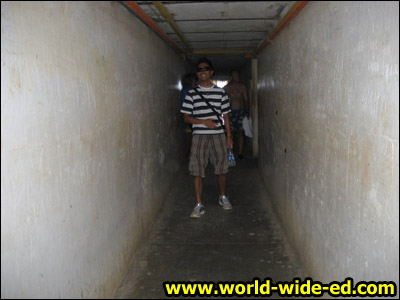
Teppei happy to be done with the stairs… for now!
Just when you thought you were safe from stairs for the rest of your life, you’ll hit a spiral staircase originally used by the Fire Control Station, which is also POI9: This lighted spiral staircase accessed the 4 levels of the Fire Control Station. Go up to the third level where the mounts for the observation equipment are still present.
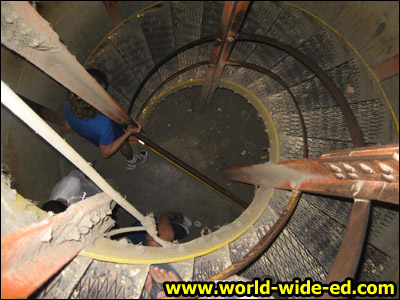
Spiral Staircase
When you get to the third floor, you’ll approach POI10 to exit the crater: Exit to the exterior of the crater through slits once covered with metal shutters.
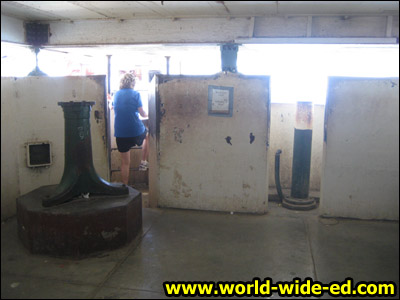
Exiting the crater
Note the rock and concrete that camouflage the structure on the seaward side.
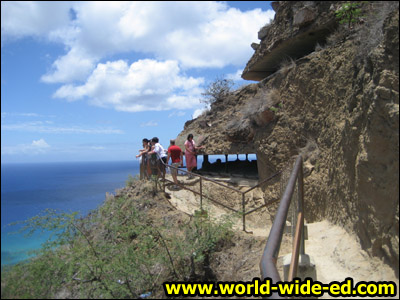
As you work your way along the crater path, POI11 comes a-callin’. Something you haven’t seen in quite some time… MORE STAIRS! Don’t fret, this is the last you’ll see until you hit the summit: The 54 metal stairs replaced the ladder to the summit in the 1970s for hiker safety.
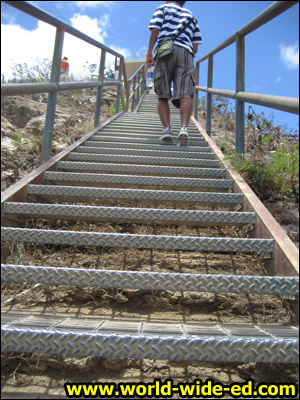
54 metal stairs to the summit.
Alas, you’ve made it to the summit of Oahu’s answer to Nepal’s Mt. Everest: Mount Diamond Head. Go ahead and pat yourself on the back. But before you get too excited, you may want to brace yourself for the cockroach-like crowd up top. Agoraphobics/Claustrophobics/Demophobics/Enochlophobics/Ochlophobics, consider yourselves warned.
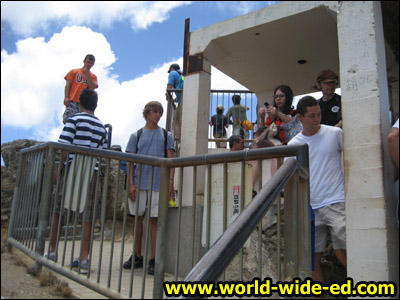
The crowd at Diamond Head’s Summit
Once you make your way through the crowd, you’ll get to our final Point of Interest, POI12: The Observation Station – The summit of the crater and the uppermost level of the Fire Control Station are at an elevation of 761 feet (232 m). Bunkers along the crater rim were built in 1915.
With its panoramic view from Koko Head to Waianae, the summit of Diamond Head was once the ideal site for the coastal defense of Oahu and, as such, was purchased by the Federal Government in 1904 and designated for military use.
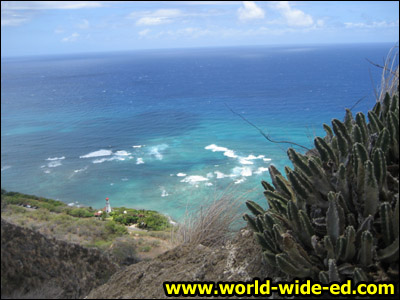
East view
Today, we can enjoy this beautiful panoramic view, as citizens, thanks to the Division of State Parks from the Department of Land and Natural Resources.
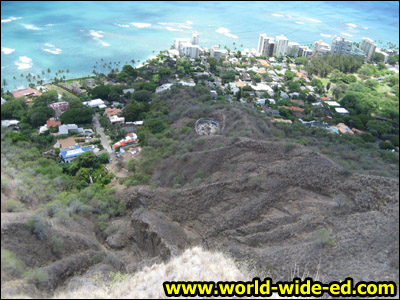
South view

West View
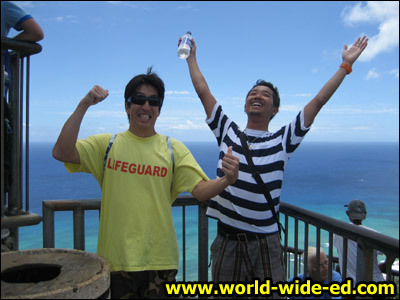
North of Crazy View
(Teppei and I showing how happy we were to have made it)
Mahalo to the Department of Land and Natural Resources, DLNR’s Public Information Officer Deborah Ward and the Division of State Parks’ Diamond Head Park Coordinator Yara Lamadrid-Rose. They would like to let everyone know that the park will be open for regular park hours (6AM-6PM) on New Year’s Day, so why not fulfill your New Year’s resolution from day 1 and start the new year right?
Diamond Head Summit Trail
4200 Diamond Head Rd, Honolulu, HI 96816 (map)
(808) 587-0285
Open daily 6AM-6PM
$1 Per Person, $5 Per Vehicle
For further information, contact:
Department of Land & Natural Resources Division of State Parks
1151 Punchbowl Street, Room 310
(P.O. Box 621)
Honolulu, HI. 96809
Phone: (808) 587-0300
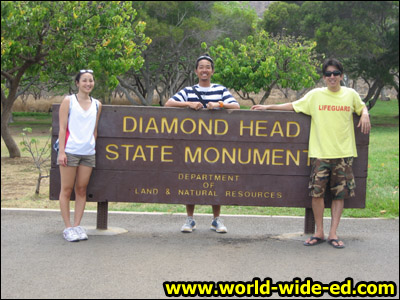
We made it! (and you can too…)